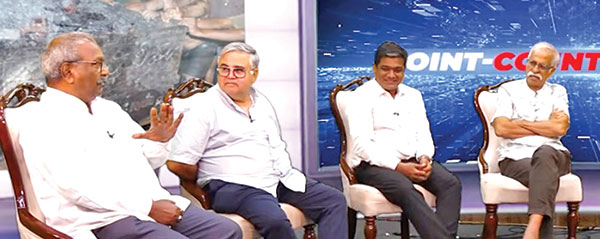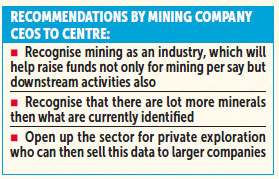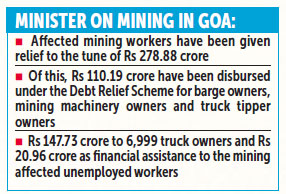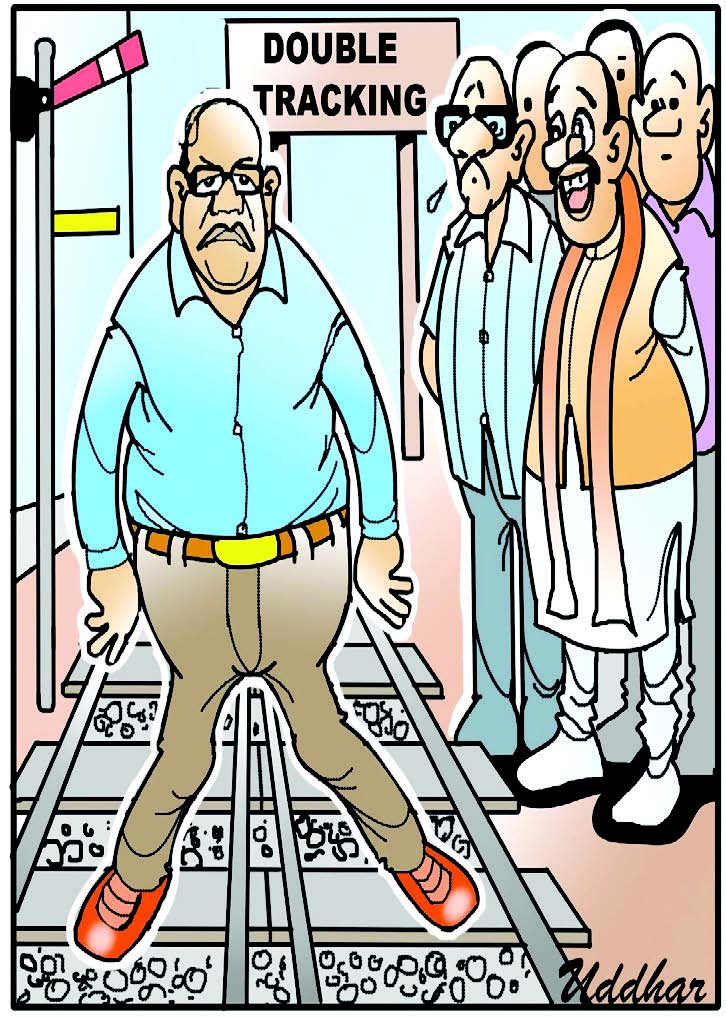
Despite all the talks revolving around resumption of iron ore mining in Goa, it continues to be on pause mode and seems to have become the biggest albatross around the neck. Everyone is concerned about getting the economy back on track and resumption of mining is the only hope.

For this to happen, the mining has to restart fast. The Union Minister of Mines, Coal and Parliamentary Affairs Prahlad Joshi, while replying to a question raised by Rajya Sabha MP Luizinho Faleiro said that the state government has initiated the process for auction of mineral blocks to restart iron ore mining. But the ground reality shows otherwise.
The Minister also mentioned that the process of restarting the mining sector will be by the Goa Mineral Development Corporation Act, 2021, notified on September 15, 2021.
The minister also disclosed that affected mining workers have been given relief to the tune of Rs 278.88 crore, of which, Rs 110.19 crore have been disbursed under the Debt Relief Scheme for barge owners, mining machinery owners and truck tipper owners, Rs 147.73 crore to 6,999 truck owners and Rs 20.96 crore as financial assistance to the mining affected unemployed workers.
While these are the claims made by the central government, what is the actual ground reality? Has the help really reached the affected people? Should we feel optimistic on hearing this reply?
Haresh Melwani, Member Managing Committee Federation of Indian Mineral Industries (FIMI) said, “Whoever is in business will always be optimistic. Question is now iron ore mining is blocked. But it can be legally mined. I think it is about time we look at the options available to us and explore the minerals comprehensively so that we don't need to mine as much iron ore for the same revenue.” Closure of mining blocks is a challenge. But according to him, that is not much of a challenge for a government which wants to do something.
“Remember that governments have vast powers and if they set out to do something they can do it. Now, we will know about the roadblocks only when we discuss things with the government. I think pretty soon we will have that discussion and we will understand what the roadblocks are,” Melwani said.
First step was to form the Goa Mineral Development Corporation, which has already been taken. now the further steps will surely follow.
But how authentic are the figures quoted by the central minister?
Priyesh Kamat, shipyard and barge owner said there is a scheme in place. But the efficacy of this scheme is more important. It is not necessary that a scheme started by the government will lead to rehabilitation of mining affected people.
“Problem is when a small barge owner or a machinery owner has taken a loan, the scheme itself expects that person to become a non-performing asset (NPA) and then we give him little benefit. The problem is it is difficult for him to even take that scheme,” Kamat said.
Citing an example he said, suppose a truck was costing Rs 20 lakh, he has taken 75% loan, which means his loan amount is Rs 15 lakh. Mining closed in 2012 September and the scheme came out in 2015 September, three years down the line he already became a defaulter. His truck which was worth Rs 15 lakh then, is today worth Rs 2 lakh.
“Government gives him Rs 5 lakh while his loan amount is Rs 15 lakh. He has to sell his house, he has become NPA and he is not going to get a loan from banks any longer. His morale is totally low and that is exactly the status of mining dependents. Problem with the current scenario is that mine owners are in good shape and their children are studying well. If you look at barge owners, some of them are also doing well. But the majority of them who come from the lower part of the social pyramid are in deep trouble,” Kamat said.
“The government may say that it has given Rs 100 crore for the mining affected, but that hasn’t helped in rehabilitating them. The money might have reached some people, but we need to understand after getting that money are they in business? They’re out of business. There are numerous cases where barge owners have got Rs 35 lakh capital subsidy yet had to sell their assets like their flat or plot. We’re struggling today,” he added.
He lamented that there is no road map for getting these people some alternative earning avenue.
“Why only mining, there are a lot of other activities the government can support. I have an excavator, a truck or a barge which need not be used to transport iron ore. It can be used as a transport container which can do a lot of things. But 10 years have passed, yet there is no road map for rehabilitating the mining affected people,” he said, adding, “Whatever the government has done is too little, too late”.
Claude Alvares, Director, Goa Foundation said that the government says something in the parliament and does something else.
“For restarting the mining, the whole exercise needs a proper road map. Now last time in 2014 the Supreme Court said the government should have a policy in place before giving fresh mining leases. So in November, they quickly came up with the policy and notified it as a draft and started giving the leases. But interestingly that documented policy was notified in January after the MMDR Act was amended, so it was no use. So the Goa Grant of Mining Leases Policy was withdrawn in 2016. As of today, there is no policy,” Alvares said.
Policy reflects a road map of what exactly the government is going to do and what exactly is the framework under which it is going to work.
“On one side you are saying that we are going to do it under the corporation. But on the other side you’re talking about the auction of mining blocks. But if you’re going to auction the mining blocks, what is the need of the Goa Mineral development corporation? If you want to have this Goa Mineral Development Corporation, then your first decision is to notify the decision of the government and ensure that all the reserves are kept with the Corporation,” he said.
Then that Corporation can issue contracts to various parties for extraction of the ore, auction the contracts, they can do whatever.
“But who is going to be the authorised person, it has to be the Corporation. But they are saying that in six months the government will begin the process of auctioning the mining blocks. That means it’s obviously going to benefit the private parties, bypassing the Corporation.
According to the Goa Mineral Development Corporation Bill and the Act thereof, it is very clearly said the government has to frame rules for the activities in the manner it has to be done, including the role of the managing director, utilisation of funds amongst others. The issue is rules have not been framed for the corporation.
Harish Melwani responded by saying that mining is a concurrent subject, wherein the State and Centre both are involved.
“About a month ago we had a meeting of 25 CEOs of mining companies with the highest authorities, including Union Mines Minister Mr (Prahlad) Joshi. Union Home Minister Mr Amit Shah visited us in that conclave. We made our recommendations on the way forward for organized mining because most of the mining company CEOs were from the corporate sector and we are not in favour of illegal mining,” he said.
Melwani reiterated that the miners want to run fully legal and organised mining.
“Our points were very well received and in fact they expressed their regret for not meeting us earlier. Our major recommendations included recognising mining as an industry, which will help raise funds not only for mining per say but downstream activities also. Recognise that we have a lot more minerals then what are currently identified. Open up the sector for private exploration who can then sell this data to larger companies. You see today the environmental social responsibility demands a larger capital structure. Then a small mine operator, if told to explore and operate mine, will cut corners to save money as he won’t be able to afford it,” he said.
So, it needs the permission to sell that data to a larger operator who can afford all these CSR activities environmentally sensitive practices. One needs sizable capital to afford these things.
The fact that the minister himself approached the mining company CEOs is a very positive initiative. But the narrative coming from the State government is they are going to restart iron ore mining. They are not talking about other minerals that have been spoken about. Also, they are talking about identifying mineral blocks and getting into iron ore mining. Question is who will be the custodian of these resources and what will be the nodal body to carry out the mining?
Melwani responded by saying that iron ore mining is completely controlled by the Centre under the MMDR Act. State government can only either seek Centre’s assistance or give its recommendations. But until the Centre agrees, iron ore is totally restricted with the Centre.
Claude Alvares however said that the Supreme Court in its 2014 judgement has said that these minerals which are part of the State, will be subject to State policy.
The Supreme Court has stated that “as per the provisions of Mines and Minerals Development and Regulation Act 1957, the State governments are responsible for the grant of mineral concession through transparent e-auction process. So, ultimately the onus is on the State government to safeguard the process.
“But unless the Centre agrees, you can’t release the lease for iron ore. The Centre has not agreed. They are pondering on the recommendations we have made. We are expecting something constructive to come out,” Melwani said.

Priyesh Kamat said that although Centre and State governments have been talking about FDIs in the mining sector, investment of small players is not being protected.
“I am a small player and my investment is not being protected. For example, someone has invested in a business like starting a hotel near a mining site. But due to the closure, his business has gone berserk. Nobody tries to find out where this hotelier is alive or dead. They are only talking about mine and barge owners, who are at the top of the social pyramid,” he alleged.
He mentioned that a lot of Goans who were associated with the allied activities related to mining doing skilled jobs earlier, are now doing unskilled jobs for survival. Somebody has become a cab driver or a food delivery man or a security guard. I am talking about this larger problem. The government should do something to rehabilitate them.
Claude Alvares said that the right solution could have been taken soon after the Goa Mineral Development Corporation started.
“All the persons skilled in mining and employed by mining companies should be hired by the Corporation. These skilled people formed the core of the mining industry for 50 years. Now since they are out of work, this is an excellent opportunity to recruit them and utilise their expertise to restart the mining in a proper manner. If you are going to bring people from outside to do it, the situation will be chaotic. Everybody needs local people as they have the experience, expertise and knowledge. So, their talent should not go to waste. That is why they have issued a threat that they won’t allow restarting of mining unless they are re-employed, which is a sad situation. Why should we have mining in the State of Goa if no Goan is going to benefit from it?,” he said.
Priyesh Kamat added that stakeholders in the mining sector are not just those who have the money.
“The real stakeholder is the person working on the ground, who is not involved in any decision making, does not have any idea on what is happening. He does not bother because he won’t be able to earn bread for his home. Aspirations of those people who are actually involved in mining should be taken care of. The establishment would perhaps not know how many miners, traders, barge owners are there. From thereon the picture is blurred. They don’t know who is there,” he said.
They form a large population who need to be involved by the government in its rehabilitation schemes. The government is aware only of those who are at the top of the pyramid. Those at the bottom are completely lost and forgotten. That is where the maximum misery lies.
Once the mining restarts, will the previous players also enter the ring? How will the situation play out?
Alvares said that the moral dictum is when somebody breaks your trust, you banish that individual from your life forever. Anybody who is involved in a crime, he or she is punished in accordance with the law, which could be even imprisonment. Here, illegal mining was done in Goa. Mining was done without a valid lease.
Comptroller and Auditor General report which indicts the miners for illegalities, says clearly about the amount of illegal mining took place, ore taken out of lease without paying the royalties, forest area destroyed as the mining was on in the wildlife sanctuaries even though they were forbidden to do so etc.
“Now if you put all these things together, do you think anybody would want to go back to the same set of actors? Rules are very clear that if you have been found involved in illegal mining, you will be barred from further participation as stated in the MMDR Act. Such a company will not be granted a fresh lease,” he said.
Priyesh Kamat added that 10 years have passed, there are about 10-12 iron ore mine owners but there is no miner named as accused by investigating authorities till now.
“If in 10 years you are not able to identify who are involved in illegalities, how are you going to filter out the tainted parties? This means that the same set of players will be in the reckoning,” he said.
Claude Alvares however clarified that the Special Investigation team (SIT) has already filed 16 FIRs in cases referred to them by the Directorate of Mines.
“The CAG in 2016 had indicted several mining companies on several grounds and pursuant to that, it had said that Rs 1,800 crore has to be recovered from them. Then there was a team of Chartered Accountants set up by former chief minister late Manohar Parrikar. That team found a default of total Rs 1,500 crore, the total being Rs 3,431 crore. The government has so far recovered only Rs 80 crore,” Alvares said.
So, evidence of wrongdoing is already there. The question here is why isn’t the government prosecuting them? The government is delaying action against the top of the pyramid. What does it mean? Government is comfortable with the people on the top of the pyramid because they are the ones who are making contributions to political parties and buying the electoral bonds. Why would the government file cases against them? It is like biting the hands that are feeding you.
Kamat said that he is not very keen on naming and shaming anybody.
“My concern is rehabilitation of those at the bottom of the pyramid because they are the ones who are suffering the most. They are unable to pay the school fees of their children. I can’t burn my house. This is a very sad story. I feel it is more important than anything else. Who gets the mines and who doesn’t is not important. How you rehabilitate the people at the bottom of the pyramid, which should have been done in the last 10 years, is my biggest concern. Unfortunately, still no one is talking about them,” he lamented.
Melwani said that there is no clarity of the legal structure of mining in Goa as yet.
“The concession matter has been pending for 30 plus years in the Supreme Court. Hopefully some clarity is brought in. So, whatever policy comes out, it can be then implemented. Otherwise there will always be some lacunae. But, can someone tell the Supreme Court to expedite the matter? This is holding up all policy decisions regarding restarting of mining,” he said.
Let us look at a situation where we’re looking at the future and who will be in charge of mining - whether the old mining guys will come in or whether we are opening up our doors to the big fish from outside Goa and take over the mining. Does it cause any fear or apprehension?
Melwani replied by saying there is nothing to fear. “Why should it cause fear? Mining needs a phenomenal amount of capital. Now if a Goan operator has access to that capital then so be it, same should be the case with someone coming from outside. As a Goan are you not permitted to go to other States of India?
“Moreover, can you carry the ore to the harbour without a barge? Answer is no. So, you will need the barge. Can you haul the ore from the jetty without the trucks? Again the answer is no. You will need the trucks. Can you load the barge without the jetty? No. So you will need the jetty owners. That is the whole chain. You will have to integrate with the locals,” he said.
Claude Alvares said that if the local population is not properly rehabilitated and brought into the mining industry, there should be no mining in the State at all.
“If only 80% of the benefit is there for Goenkars from the population working in the mining industry, then only you can restart and that is where the material benefit from mining to Goa lies. If you’re going to allow the environment to be disturbed it must be for a good purpose. It must be because people need a job, people need income and therefore the benefit has to go to them primarily.
“We have been working very hard to ensure that every Goenkar benefits from the economic aspects of mining. That means this entire industry where you have three or four or five people at the top making their money and then doing double invoicing and parking their excess money abroad, that that is a thing of the past,” he said.
According to Alvares, what we need today is that whatever you gain from mining, will go into the permanent fund or into the public exchequer, from which there will be a dividend for every citizen.
“We have given the schemes to the government. Even the NITI Ayog had commissioned a report. In that report it had stated that we made some very good suggestions but did not get a response from the State government,” added.
It has been 10 years since mining stopped in Goa. Three elections have happened and a lot of promises made. So, what is the confidence level of the mining stakeholders at this point of time?
Puti Gaonkar, President of the Goa Mining People's Front (GMPF) was forthright in his reply when he said he doesn’t have any confidence.
“On February 7, 2018 the Supreme Court directed both the State and Central government to commence mining immediately in Goa. Thereafter in 2019 during his election campaigning in Goa, Prime Minister Narendra Modi gave assurances to the public and later in a meeting with me of resolving all the issues to restart mining. It’s been three years now, nothing has happened. If they really want to restart the mining, auctions could have been held long time back,” Gaonkar said
The Supreme Court in its order had given clear directions, which were not followed. The reason for it is best known to Centre and State, he added.
“Not a single penny has been paid to anybody after 2018. Neither the workers nor barge owners or barge workers got any money. We are talking about employment and the economy of the State. Rehabilitation process has to be coupled with employment. State has lost revenue amounting to Rs 3,300 cr in income tax. There are other levies also. There is a 30 per cent levy, district fund is. There is also another cess. Who stopped the State government from imposing the levies further?” the mining union leader said.
There is clearly a lot of gap between what the government at the Centre and State says and what is actually happening on ground. It is time that the government takes a serious view of the situation because any further delay will mean prolonging the agony of mining affected people. This will certainly not augur well for the State of Goa – socially or economically.
